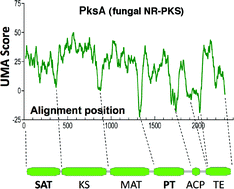Aflatoxin and deconstruction of type I, iterative polyketide synthase function
Abstract
In this viewpoint highlights are drawn from a deep analysis of the multifaceted problem of aflatoxin biosynthesis, one of the most highly rearranged polyketide natural products known. Fundamental chemical insights have emerged into how cytochrome P450-mediated skeletal rearrangements occur through probable cationic intermediates and oxidative dearomatizations, which are applicable more widely in natural product catabolism. So to where current experimental methods have failed in our hands, bioinformatic tools and fresh experimental strategies have been developed to identify linker regions in large, polydomain proteins and guide the dissection and reassembly of their component parts. It has been possible to deduce individual catalytic roles, how overall synthesis is coordinated and how these enzymes can be re-engineered in a rational manner to prepare non-natural products. These insights and innovations were often not planned or anticipated, but sprung from the inability to answer fundamental questions. Advances in science can take place by chance favoring the prepared mind, other times by refusing to give up and devising new solutions to address hard questions. Both ways forward played important roles in the investigation of aflatoxin biosynthesis. For these contributions I am pleased to share this special issue of NPR with John Vederas and Tom Simpson, who have been leaders in this field for the last third of a century.

- This article is part of the themed collection: Fungal Natural Products

 Please wait while we load your content...
Please wait while we load your content...